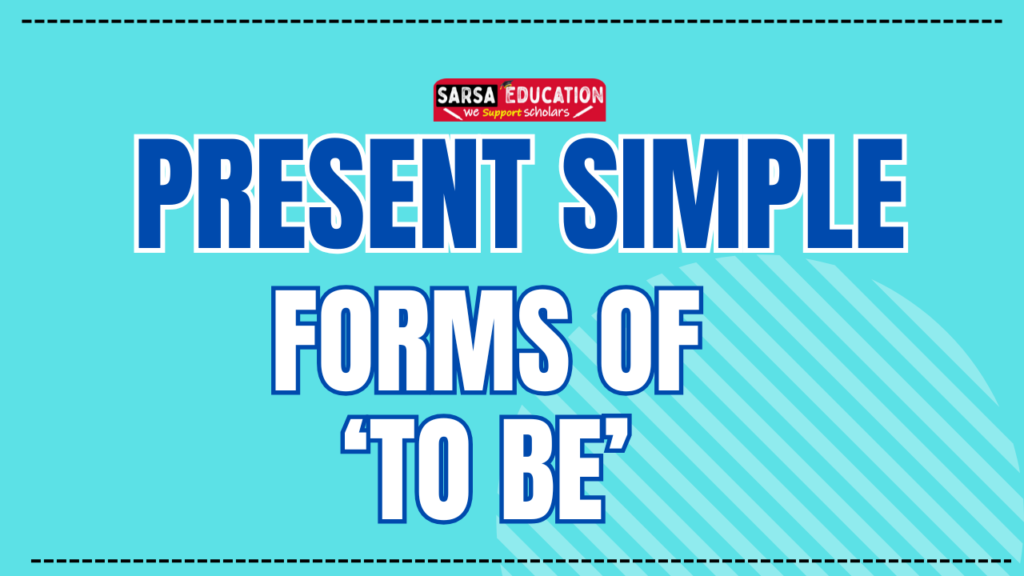Present simple forms of ‘to be’ – am/is/are
The present simple Forms of ‘to be’ is used to describe permanent or general truths, habits, routines, and characteristics about people, places, and things.
- I am (first person singular)
- You are (second person singular and plural)
- He/She/It is (third person singular)
- We are (first person plural)
- They are (third person plural)
Examples: –
- I am a student.
- You are very kind.
- He/She/ is a good person.
- It is an adorable cat.
- We are from India.
- They are my friends.
- She is Indian.
- We are French.
| I he, she, it | am am not is is not | ’m ’m not ’s isn’t | Student |
| we, you, they | are | – ’re – are not – aren’t / ’re not | |
| Am Is Are | I he, she, it we, you, they | – Player |
Present simple forms of ‘to be’ – am/is/are used –
1. “Am“- Used with the subject “I”.
Example: I am happy.
I am a programmer.
I am excited.
I am a teacher.
2. “Is“- Used with singular third-person subjects (he, she, it).
Example: He is lawyer.
She is a doctor.
It is cold outside.
Read also: Worksheet Present Simple forms
Read also: Worksheets Present Simple tense
3. “Are“- Used with plural subjects (we, you, they) and with you (singular or plural).
Example: We are friends.
They are students.
You are Intelligent.
Structure of Present Simple Forms of “To Be”-
Affirmative Form: These sentences state facts or describe people, places, or things.
Subject + am/is/are + Subject Complement
Examples:
- I am a Scientist.
- I am a student.
- She is a doctor.
- He is very tall.
- It is a beautiful day.
- You are my best friend.
- We are in the same class.
- They are at the park.
Present simple forms
1. Affirmative Sentences (Positive Statements)
These sentences state facts or describe people, places, or things.
- I am a student.
- She is a doctor.
- He is very tall.
- It is a beautiful day.
- You are my best friend.
- We are in the same class.
- They are at the park.
2. Negative Sentences:
To make a sentence negative, add “not” after am, is, or are.
Subject + am/is/are + not + Subject Complement
Examples:
- I am not a doctor.
- I am not hungry.
- She is not at home.
- He is not a teacher.
- It is not cold today.
- You are not late.
- We are not ready.
- They are not in the house.
Read also: Day 15: Present simple –Do/Does?
Present simple forms
3. Questions (Interrogative Sentences)
To ask a question, put am, is, or are before the subject.
- Yes/No Question Form: Am/Is/Are + subject + Subject Complement?
Examples:
- Am I a good singer?
- Am I right?
- Is she your sister?
- Is he a good player?
- Is it your book?
- Are you ready?
- Are we late?
- Are they in the garden?
Short Answers
When answering yes/no questions, we use “Yes” or “No” with “to be.”
- Is she your friend? → Yes, she is. / No, she isn’t.
- Are they at school? → Yes, they are. / No, they aren’t.
- Am I correct? → Yes, you are. / No, you aren’t.
- Informative or Wh-Question Form: Wh-word + am/is/are + subject + Subject Complement?
Examples:
- What am I?
- Who is he?
- Who are they?
- What is your father?
- Where is the English book?
- Where is your sister?
- What is your nationality?
- Where are you from?
- What is your profession?
- Where is the Taj Mahal?
Short forms (contractions):
- I am – I’m
- You are – You’re
- He/She/It is – He’s/She’s/It’s
- We are – We’re
- They are – They’re
Negative Contractions-
- I am not – I’m not
- You are not – You’re not
- He/She/It is not – He’s not/She’s not/It’s not
- We are not – We’re not
- They are not – They’re not
For regular English Speaking Course updates, kindly join our Telegram channel
Follow the Sarsa Education channel on Telegram: https://shorturl.at/R5WKa

